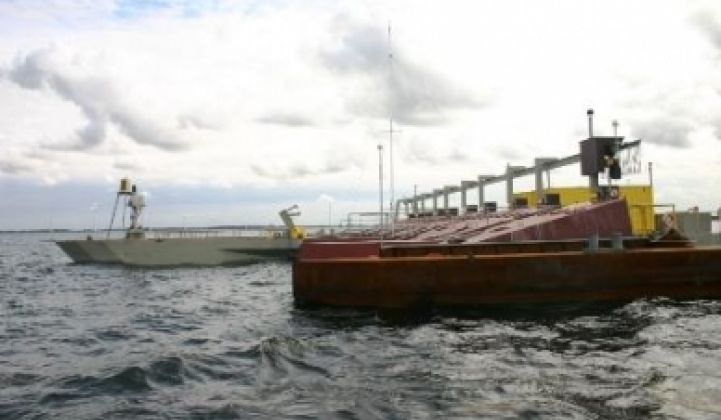Since offshore wind turbines generally work best in the world's worst seas, you might as well try to generate wave power at the same time.
That's the basic idea behind Floating Power Plant, a Danish company that says it has designed a platform that can house wind turbines as well as harvest energy from the surrounding waves. The company has built a small prototype, is in the midst of completing a larger one, and ultimately hopes to build a commercial version that will sport three 1.5-megawatt to 2-megawatt wind turbines or a single 5-megawatt turbine.
In all, the commercial version of its Poseidon power plant could generate up to 40 to 50 gigawatt hours of energy a year, depending on the waves and the wind, according to the company. The company will detail more of its plans at Nordic Green II, taking place on April 27 and 28 at SRI International in Menlo Park, California.
If it works, it could give a boost to the struggling wave energy market. Wave and tidal power companies like OpenHydro and Pelamis have tested concept devices for generating power from the seas, but the actual number of kilowatts generated from waves and tides remains minuscule. Financiers are also particularly skittish about investing in wave and tidal because of the high capital costs and the risks associated with trying to build something that will work flawlessly for decades on the high seas.
Topping a wave system with wind turbines takes out some of the risk. Offshore turbines are a proven, stable technology. Thus, even if the wave generators don't produce as much energy as planned, at least the investors will see revenue from wind energy. In a sense, this model could be viewed as an offshore wind turbine with wave energy thrown in as a bonus.
The risk is further diminished by the design of the wave power platform. It's big. The company borrowed heavily from the engineering techniques behind the floating platforms that have been built by the oil industry for years. The platform's sheer size insulates it from hazards posed by rogue waves and 100-year storms. (In Scotland, SeaEnergy Renewables is taking a similar conceptual approach and building mounts for offshore wind turbines that are based around the pylons, known as jackets, for oil drilling.)
The current demonstration platform (see photo) launched in September 2008 in Denmark and weighs 350 tons, or 450 tons with ballast. The side facing oncoming waves is 37 meters wide, and the entire platform is 25 meters long and six meters high. The devices that capture wave power beneath the surface are six meters long and weigh 4.7 tons, and bear a resemblance to skateboarding ramps. Underwater, they swing up and down in a 2.5 meter range to capture energy.
Floating Power Plant will next top its demo platform with three 11-kilowatt wind turbines and test the complete rig through 2011.
The commercial version of the plant will have a wave-facing front that extends 230 meters, stretches back 25 meters, dips into the ocean around 25 meters, and weighs about 20,000 to 30,000 tons.
Power from the plant will cost 10 to 15 euro cents per kilowatt hour. That's a little expensive compared to U.S. power now, which averages around 11 cents a kilowatt hour, but power in Europe costs more and U.S. power prices are expected to rise.



